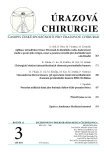Injury of soft tissues as limiting factor in treatement fractures of lower leg
Authors:
Jan Spudich
Authors‘ workplace:
Chirurgické oddělení Nemocnice Most, o. z., Krajská zdravotní a. s.
Published in:
Úraz chir. 21., 2013, č.3
Overview
BACKGROUND:
Injury of lower leg has his specifics first of all because of the injury of soft tissues. The choice of implant and timing of definitive solution of soft tissue defects are the basic keys in treatement algorithm.
MATERIAL AND RESULTS:
Author gives hereby the experience from his departement with the treatement of lower leg injuries in the last 10 years.
DISCUSSION:
The injury of soft tissues is strongly dependent on the level of lower leg. Fast and correct solution of the injury of soft tissues plays the key role. The right timing of definitive osteosynthesis is crucial.
CONCLUSION:
The correct common solution of soft tissue injury by fractures of lower leg is the key factor which influence the final prognosis of the treatement. In the level of proximal and middle third tibia it is possible in most cases to treat the injury of soft tissues and provide osteosynthesis in one procedure. On contrary by fractures of distal third tibia and first of all by pilon fractures it is necessary to use often more phases. It is crucial to solve the soft tissue injury definitively in the period of 1 week.
Key words:
soft tissues, level of lower leg, soft tissue cover.
Sources
1. AHMED, B., DIN, MD. Distally Based Sural Fasciocutaneous Flap for Coverage of Foot Defects. J Plast Reconstr Surg. 2006, 2, 93–99.
2. GUSTILO, RB, ANDERSON, JT. Problems in the management of type III open fractures, a new classification of type III open fractures. J Trauma. 1987, 24, 742–746.
3. HEPPENSTAHL, RB. Compartement syndrome. Diagnosis and Treatment-Techniques Orthop. 1997, 12, 92–108.
4. MUBARAK, SJ., OWEN, CA. Double-incision fasciotomy of the lower leg for decompression in compartement syndrome. J Bone Joint Surgery Am. 2008, 59, 184–187.
5. LEVIN, ST., CONDIT, DP. Combined injuries- soft tissue management. Clin Ortop Related Res. 1996, 327, 172–181.
6. NEJEDLÝ, A., DŽUPA, V.,TVRDEK M. Využití muskulárního laloku při léčení infikovaných zlomenin a chronické osteomyelitidy v oblasti bérce a hlezna. Acta Chirurgiae Orthopaedicae et Traumatologiae Čechoslovaca. 2007, 74, 162.
7. RUEDI, T., BUCKLEY, R., MORAN, CH. AO Principles of Fracture Management. 2007, 1 sv., 86–108.
8. TŘEŠKA, V., ČECHURA, M., ČERTÍK, B. Poranění končetinových cév, naše zkušenosti a výsledky. Rozhledy v chirurgii. 2002, 1, 7–10.
9. TSCHERNE, H. Wound management of fracture with soft tissues damage. Chirurgie. 1983, 38, 34–39.
10. VESELÝ, R., PROCHÁZKA, V., KOČIŠ, J., PAŠA, L. Rekonstrukce defektů měkkých tkání dolní třetiny bérce, hlezna a nohy použitím suralis laloku. Rozhledy v chirurgii. 2007, 86, 8–11.
Labels
Surgery Traumatology Trauma surgeryArticle was published in
Trauma Surgery

2013 Issue 3
- Metamizole vs. Tramadol in Postoperative Analgesia
- Metamizole at a Glance and in Practice – Effective Non-Opioid Analgesic for All Ages
- The Importance of Hydration in Wound Healing
- Obstacle Called Vasospasm: Which Solution Is Most Effective in Microsurgery and How to Pharmacologically Assist It?
- Possibilities of Using Metamizole in the Treatment of Acute Primary Headaches
Most read in this issue
- Injury of soft tissues as limiting factor in treatement fractures of lower leg
- Humerus head osteonecrosis in surgical treatment intraarticular fractures of proximal humerus by PHILOS plate
- Surgery treatment intraarticular fractures of proximal humerus
- Micronail Insertion into Cadaver Distal Radius: A Study of Insertion Location, Rotation and Screw Articular and Cortical Penetration
